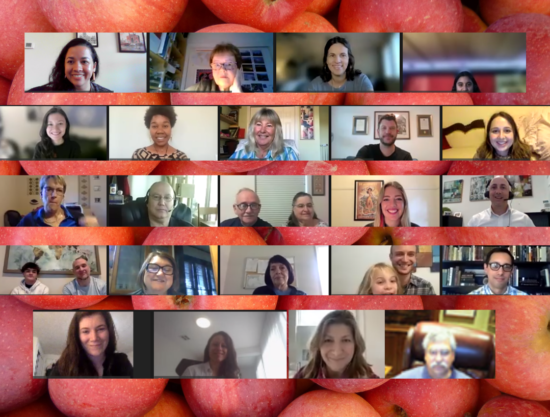By Jena Melançon, Founder & Executive Director, Gulf Coast Diplomacy

Australian IVLP participants and Pensacola locals share a virtual Thanksgiving celebration. Photo courtesy of Gulf Coast Diplomacy
What’s not to like about Thanksgiving home hospitality? Even when the conversation about family traditions takes place through a computer screen, it is a great way to introduce your community’s culture to international visitors. This year, we tweaked our traditional offering since we could not pass the cranberry sauce in person and created cultural hospitality for a group of Australian IVLP participants who came to us via Meridian International.
We reached out to our membership and professional resources via email to create the guest list. We also contacted the parents of youth who had participated in an ECA exchange with us earlier in the year. At a November conference in downtown Pensacola, we targeted additional locals to make the invitation list more robust. We also advertised the opportunity on social media and used LinkedIn to connect us to young professionals.
We ended up coordinating with a family that was planning to celebrate Thanksgiving earlier in the week. Happily, their dinner fell on the day of our cultural hospitality. We asked U.S. attendees to submit a family recipe and designed a recipe book to share with everyone after the event. For those looking for a new recipe for green bean casserole, shoot us an email. We have two different ones to share.
When the big day arrived, we had a brief site visit to the host family’s kitchen and dining room table. We even took a peek in their oven at the roasting turkey. Then, in rotating breakout rooms, we used one of our favorite facilitation tools to get visitors and locals talking about various topics.
Although we did not eat during the event, it certainly felt festive. You don’t have to dine to experience the spirit of Thanksgiving. Take your enthusiasm for citizen diplomacy, add a few props and relevant questions, and mix them. Within short order, you will have all you need for a Thanksgiving exchange, except for a kiddie table and the pulling of a wishbone. (Note to self: Next time, figure out how to incorporate a virtual wishbone.)
RECIPE FOR SUCCESS
Ingredients: Two co-facilitators; IVLP participants; a variety of locals willing to explore virtual exchange in all its glory; welcoming music; questions to entertain and delight; a design tool to create an attractive recipe book; optional: gimbal for site visit vignette
Prep Time: Four weeks to recruit local attendees. Depending on the responsiveness of your community, prepare to devote six to 35 hours in this effort; To collect submissions and design the recipe book, budget six to eight hours; Budget an additional two hours to prepare any new American attendees by taking the time to explain the importance of the IVLP and the role of citizen diplomacy.
Steps:
- Be in contact with locals who sign up for your event. They will be more likely to show up if they have had a personal connection with you. If you depend on Zoom registration alone, you most likely will be disappointed in the turnout. With minimal post-registration contact, approximately 25% of those who sign up for a free event over Zoom will show. By reminding them of the person behind the computer, we have increased our Zoom attendance rate to 75%.
- Ask your locals to submit recipes a week in advance. Your staff member will have time to supplement the collection if you need to add an essential dish.
- Don’t forget to send a reminder email with a video conferencing link to your locals the day before the event. Not everyone is as organized as you.
- Set the festive mood with music. Have fun with it, and get guests engaged when they enter your space. As people arrive, ask a question everyone can answer in chat. Ours was, “What are you grateful for today?”
- Prepare questions in advance that touch upon the visitors’ program theme and questions that have absolutely nothing to do with their IVLP. Use these questions as props to get the conversation going, not as attendee assignments.
- Decide in advance how to distribute your locals in breakout rooms. As with all programming, aim for diversity. Plan to have at least two IVs per room but no more than three. Keep the number of total attendees per breakout room to 10 or fewer.
- Consider how you want to run your breakout rooms. Random rooms are an option, but we like our international visitors to meet each non-IVLP attendee. If we have fewer IVs than locals, we will move the IVs from room to room, keeping the locals in place when it is time to switch to a new space.
- Fifteen minutes before the end of the event, bring everyone back to the main room for their final thoughts.
- If you have media permission, be kind to your social media staff member and select “hide all non-video participants” before taking a screenshot. This will eliminate unattractive black boxes and potentially increase the size of the attendee boxes, making for a nicer photograph.
Recipe Modification:
If you use interpreters, you won’t use breakout rooms, so plan to invite fewer locals.
